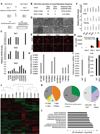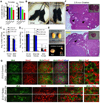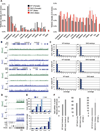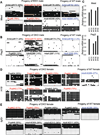Combined deficiency of Tet1 and Tet2 causes epigenetic abnormalities but is compatible with postnatal development
- PMID: 23352810
- PMCID: PMC3574201
- DOI: 10.1016/j.devcel.2012.12.015
Combined deficiency of Tet1 and Tet2 causes epigenetic abnormalities but is compatible with postnatal development
Abstract
Tet enzymes (Tet1/2/3) convert 5-methylcytosine (5mC) to 5-hydroxymethylcytosine (5hmC) in various embryonic and adult tissues. Mice mutant for either Tet1 or Tet2 are viable, raising the question of whether these enzymes have overlapping roles in development. Here we have generated Tet1 and Tet2 double-knockout (DKO) embryonic stem cells (ESCs) and mice. DKO ESCs remained pluripotent but were depleted of 5hmC and caused developmental defects in chimeric embryos. While a fraction of double-mutant embryos exhibited midgestation abnormalities with perinatal lethality, viable and overtly normal Tet1/Tet2-deficient mice were also obtained. DKO mice had reduced 5hmC and increased 5mC levels and abnormal methylation at various imprinted loci. Nevertheless, animals of both sexes were fertile, with females having smaller ovaries and reduced fertility. Our data show that loss of both enzymes is compatible with development but promotes hypermethylation and compromises imprinting. The data also suggest a significant contribution of Tet3 to hydroxylation of 5mC during development.
Copyright © 2013 Elsevier Inc. All rights reserved.
Figures







References
-
- Bernstein BE, Mikkelsen TS, Xie X, Kamal M, Huebert DJ, Cuff J, Fry B, Meissner A, Wernig M, Plath K, et al. A Bivalent Chromatin Structure Marks Key Developmental Genes in Embryonic Stem Cells. Cell. 2006;125:315–326. - PubMed
-
- Branco MR, Ficz G, Reik W. Uncovering the role of 5-hydroxymethylcytosine in the epigenome. Nat Rev Genet. 2011:1–7. - PubMed
Publication types
MeSH terms
Substances
Associated data
- Actions
- Actions
Grants and funding
LinkOut - more resources
Full Text Sources
Other Literature Sources
Molecular Biology Databases

